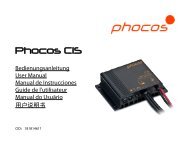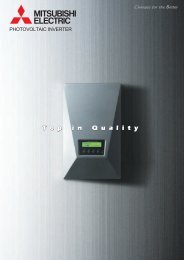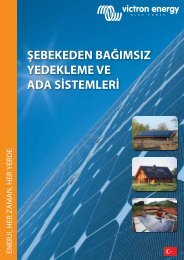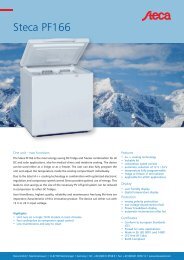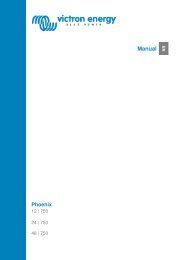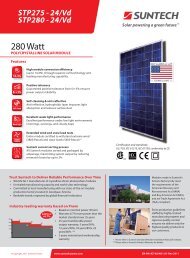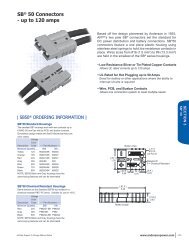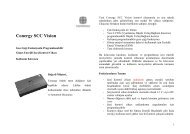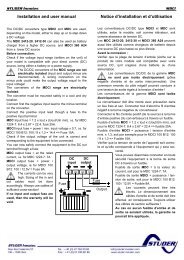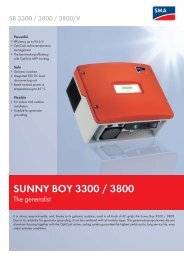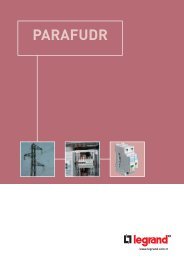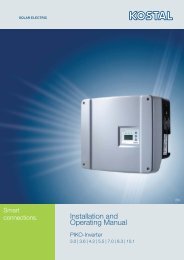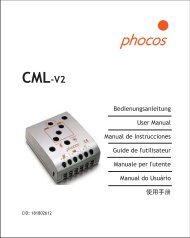MBR 12/24-100, MBR 12/24-160 AND MBR 12/24-500 - Solar-Bazaar
MBR 12/24-100, MBR 12/24-160 AND MBR 12/24-500 - Solar-Bazaar
MBR 12/24-100, MBR 12/24-160 AND MBR 12/24-500 - Solar-Bazaar
Create successful ePaper yourself
Turn your PDF publications into a flip-book with our unique Google optimized e-Paper software.
BATTERY SEPARATOR<strong>MBR</strong> <strong>12</strong>/<strong>24</strong>-<strong>100</strong>, <strong>MBR</strong> <strong>12</strong>/<strong>24</strong>-<strong>160</strong> <strong>AND</strong><strong>MBR</strong> <strong>12</strong>/<strong>24</strong>-<strong>500</strong>DescriptionThe battery separators (<strong>MBR</strong>) are powerfulmechanical contactors microprocessorcontrolled. A <strong>MBR</strong> can be used in a systemconsisting of 2 batteries (a start and anauxiliary battery), like for instance inboats or in camping-cars.PossibilitiesConnection according to the startbattery voltage(See Connection p. 2)In some <strong>12</strong>/<strong>24</strong> V installations (like in avehicle), it is preferable that the auxiliarybattery or the appliances are poweredonly if the start battery voltage issufficient. By connecting a <strong>MBR</strong> betweenthe start battery and the auxiliary batteryor the appliances, the latter will be thenpowered only once the start batteryvoltage has reached 13.2/26.4 V during60 seconds.auxiliary battery. In using a <strong>MBR</strong>, the startbattery will also be charged if the voltageof the second battery is higher than13.2/26.4 V during 5 seconds. In caseyour boat/vehicle would stay withoutrunning for a long time, your start batterywill then still remain <strong>100</strong>% charged. Fromthe stop of the charger, the contactor willopen as soon as it detects a voltagethreshold below <strong>12</strong>.8/25.6 V during 60seconds.Contact for start assistance(See Connection p. 2)By connecting the terminal STATUS to thepositive (+) pole of the auxiliary batteryvia the start contactor, the <strong>MBR</strong> willcommute the second battery at the startof your boat/camping-car.Security in case of overvoltage(See Connection p. 2)In case for instance of a fault of thealternator voltage regulator, the systemvoltage can easily overcome the voltagelimits allowed for the auxiliary batteryand/or the appliances. This is why, in caseof an overvoltage, the <strong>MBR</strong> will detect thefault and will disconnect the auxiliarybattery and/or the appliances in order toprotect them.Connection of a charger to theauxiliary battery(See Connection p. 2)This is usual, in a boat or in a camping-carto connect a battery charger to the517/<strong>MBR</strong> User manual (En–Fr–De–Sp) 1 / 8 V2.0.0
STUDER Innotec<strong>MBR</strong> – User ManualConnection for the <strong>MBR</strong> <strong>12</strong>/<strong>24</strong>-<strong>100</strong>and -<strong>160</strong>30 Positive pole (+) of the start battery85 Ingnition contact (only if « startassistance » is wished)86 Negative pole (-) of the systemCaution, this pole must always beconnected !87 Connected to the positive pole (+) of theauxiliary battery (state of the variablerelay as per the voltage)Connection for the <strong>MBR</strong> <strong>12</strong>/<strong>24</strong>-<strong>500</strong>A1 Positive pole (+) of the start battery.A2 Positive pole (+) of the auxiliarybattery or of the appliances.STAT. 3 modes1 Connected to the positive pole (+),relay closed.2 No voltage, state of the variablerelay as per the voltage.3 Connected to the negative pole (-),relay closed.LEDMIN.Not used.Negative pole (-) of the system.Caution, this pole must always beconnected !Warning ! The start and auxiliary batteries must always have the same nominal voltage !Technical specifications<strong>MBR</strong> <strong>12</strong>/<strong>24</strong>-<strong>100</strong> and (-<strong>160</strong>) <strong>MBR</strong> <strong>12</strong>/<strong>24</strong>-<strong>500</strong>Voltage Automatical detection Automatical detectionBatteries connection M6 M8Other connections Male poles 6,3 mm Male poles 6,3 mmRecommended cable Min. 25 mm² Min. 50 mm²Nominal current <strong>100</strong> A / (<strong>160</strong> A) <strong>500</strong> APeak current 480 A / 250 ms 2000 A / 250 msStart voltage 13,2 V@<strong>12</strong> V / 26,4@<strong>24</strong> V 13,2 V@<strong>12</strong> V / 26,4@<strong>24</strong> VConnection delays 5 s 5 sDisconnection delays 60 s 60 sFast disconnection 11,8 / 23.6 V 11,8 / 23.6 VFast disconnection delays 4 s 4 sStop in case of overvoltage 16 V@<strong>12</strong> V / 32 V@<strong>24</strong> V 16 V@<strong>12</strong> V / 32 V@<strong>24</strong> VIP code IP54 IP54Consumption relay open 1,5 mA@<strong>12</strong> V / 1.5 mA@ <strong>24</strong> V 1,8 mA@<strong>12</strong> V / 2 mA@ <strong>24</strong> VConsumption relay closed 360 mA@<strong>12</strong> V / <strong>160</strong> mA@<strong>24</strong> V <strong>160</strong> mA@<strong>12</strong> V / <strong>100</strong> mA@<strong>24</strong> VStart consumption (<strong>100</strong> ms) 3 A@ <strong>12</strong> V / 1,5 A@<strong>24</strong> V 3 A@ <strong>12</strong> V / 1,5 A@<strong>24</strong> VWeight 286 g 417 gDimensions (L x w x h) [mm] 93 x 46 x 77 80 x 70 x 72517/<strong>MBR</strong> User manual (En–Fr–De–Sp) 2 / 8 V2.0.0
SEPARATEUR DE BATTERIES<strong>MBR</strong> <strong>12</strong>/<strong>24</strong>-<strong>100</strong>, <strong>MBR</strong> <strong>12</strong>/<strong>24</strong>-<strong>160</strong> ET<strong>MBR</strong> <strong>12</strong>/<strong>24</strong>-<strong>500</strong>DescriptionLes séparateurs de batteries (<strong>MBR</strong>) sontdes contacteurs mécaniques de fortepuissance pilotés par microprocesseur. Un<strong>MBR</strong> peut être utilisé lorsqu'un systèmeest composé de 2 batteries (une batteriede démarrage et une batterie auxiliaire)ou d’une batterie de démarrage et desappareils alimentés en courant continu(lampe <strong>12</strong>Vdc, etc...) comme par exemplesur des bateaux ou des camping-cars.PossibilitésConnexion en fonction de la tensionde batterie de démarrage(Voir Raccordement p. 2)Pour certaines installations <strong>12</strong>/<strong>24</strong> V, il estsouhaitable que la batterie auxiliaire ou lesappareils soient uniquement alimentés si leniveau de la tension de batterie de démarrageest suffisant. En connectant un <strong>MBR</strong> entre labatterie de démarrage et la batterie auxiliaireou les appareils, ceux-ci seront donc alimentéslorsque la tension de la batterie de démarrageaura atteint 13.2/26.4 V durant 60 secondes.Raccordement d’un chargeur sur labatterie auxiliaire(Voir Raccordement p. 2)Il est courant, sur un bateau ou dans uncamping-car, de raccorder un chargeur debatterie sur la batterie auxiliaire. Enutilisant un <strong>MBR</strong>, la batterie de démarragesera également chargée si la tension de ladeuxième batterie est supérieure à13.2/26.4 V durant 5 secondes. Dans lecas d’un arrêt prolongé de votrebateau/véhicule, votre batterie dedémarrage restera donc chargée à <strong>100</strong>%.Dès l’arrêt du chargeur, le contacteurs'ouvrira aussitôt après avoir détecté unniveau de tension inférieur à <strong>12</strong>.8/25.6 Vdurant 60 secondes.Contact d’aide au démarrage(Voir Raccordement p. 2)En connectant la borne STATUS à la bornepositive (+) de la batterie auxiliaire via lecontacteur de démarrage, le <strong>MBR</strong>commutera la deuxième batterie lors dudémarrage de votre bateau/camping-car.Sécurité en cas de surtension(Voir Raccordement p. 2)Dans le cas par exemple d’un défaut durégulateur de tension de l'alternateur, latension du système peut facilementdépasser les limites de tensions autoriséespour la batterie auxiliaire et/ou lesappareils. C’est pourquoi, en cas desurtension, le <strong>MBR</strong> détectera le défaut etdéconnectera les appareils et/ou labatterie auxiliaire afin de les protéger.517/MBC User manual (En–Fr–De–Sp) 3 / 8 V2.0.0
STUDER Innotec<strong>MBR</strong> – Manuel utilisateurRaccordement pour le<strong>MBR</strong> <strong>12</strong>/<strong>24</strong>-<strong>100</strong> ET -<strong>160</strong>Raccordement pour le<strong>MBR</strong> <strong>12</strong>/<strong>24</strong>-<strong>500</strong>30 Borne positive (+) de la batterie dedémarrageA1Borne positive (+) de la batterie dedémarrage.85 Contact d’allumage (seulement si "l’aideau démarrage" est souhaitée)86 Borne négative (-) du système.Attention, cette borne doit toujoursêtre raccordée !87 Relié à la borne positive (+) de la batterieauxiliaire (état du relais variable enfonction de la tension)A2 Borne positive (+) de la batterieauxiliaire ou des appareils.STAT. 3 modes1 Relié à la borne positive (+), relaisfermé.2 Aucune tension, état du relaisvariable en fonction de la tension.3 Relié à la borne négative (-), relaisfermé.LEDMIN.Non utilisé.Borne négative (-) du système.Attention, cette borne doit toujoursêtre raccordée !Avertissement ! La batterie de démarrage et la batterie auxiliaire doivent toujours être de tensionnominale identique !Spécifications techniques<strong>MBR</strong> <strong>12</strong>/<strong>24</strong>-<strong>100</strong> et (-<strong>160</strong>) <strong>MBR</strong> <strong>12</strong>/<strong>24</strong>-<strong>500</strong>Tension d'alimentation Détection auto. de la tension Détection auto. de la tensionRaccords batteries M6 M8Autres raccordements Bornes Faston 6,3 mm Bornes Faston 6,3 mmCâble conseillé Min. 25 mm² Min. 50 mm²Courant nominal <strong>100</strong> A / (<strong>160</strong> A) <strong>500</strong> ACourant crête 480 A / 250 ms 2000 A / 250 msTension de démarrage 13,2 V@<strong>12</strong> V / 26,4@<strong>24</strong> V 13,2 V@<strong>12</strong> V / 26,4@<strong>24</strong> VDélais à la connexion 5 s 5 sDélais à la déconnexion 60 s 60 sDéconnexion rapide 11,8 / 23,6 V 11,8 / 23,6 VDélais de déconnexion rapide 4 s 4 sArrêt en cas de surtension 16 V @ <strong>12</strong> V / 32 V@<strong>24</strong> V 16 V@<strong>12</strong> V / 32 V@<strong>24</strong> VCode IP IP 54 IP 54Consommation relais ouvert 1,5 mA@<strong>12</strong> V / 1.5 mA@ <strong>24</strong> V 1,8 mA@<strong>12</strong> V / 2 mA@ <strong>24</strong> VConsommation relais fermé 360 mA@<strong>12</strong> V / <strong>160</strong> mA@<strong>24</strong> V <strong>160</strong> mA@<strong>12</strong> V / <strong>100</strong> mA@<strong>24</strong> VConsommation de démarrage (<strong>100</strong> ms) 3 A@ <strong>12</strong> V / 1,5 A@<strong>24</strong> V 3 A@ <strong>12</strong> V / 1,5 A@<strong>24</strong> VPoids 286 g 417 gDimensions (L x l x h) [mm] 93 x 46 x 77 80 x 70 x 72517/MBC User manual (En–Fr–De–Sp) 4 / 8 V2.0.0
BATTERIERELAIS<strong>MBR</strong> <strong>12</strong>/<strong>24</strong>-<strong>100</strong>, <strong>MBR</strong> <strong>12</strong>/<strong>24</strong>-<strong>160</strong> UND<strong>MBR</strong> <strong>12</strong>/<strong>24</strong>-<strong>500</strong>BeschreibungDie Batterierelais (<strong>MBR</strong>) sindLeistungsstarke mechanische Kontakteangesteuert von einem Mikroprozessor.Ein <strong>MBR</strong> kann verwendet werden wenneine System aus zwei Batterien besteht(Starter- und Hilfsbatterie), oder einerStarterbatterie und Gleichstromverbrauchern(<strong>12</strong>V Lampe, usw…), wie zumBeispiel auf Booten oder Camping-Cars.AnwendungenAnschluss abhängig von derStarterbatteriespannung(Siehe Anschlussplan S. 2)Für gewisse <strong>12</strong>/<strong>24</strong>V Installationen (inFahrzeugen zum Beispiel), ist eswünschenswert dass die Hilfsbatterie unddie daran angeschlossenen Verbrauchernur versorgt werden, wenn dasSpannungsniveau der Starterbatteriehoch genug ist. Durch den Anschlusseines <strong>MBR</strong> zwischen der Starter- und derHilfsbatterie, wir diese daher nur versorgtwenn die Starterbatteriespannungwährend mindestens 60 Sekunden bei13.2V/26.4V liegt.Anschluss eines Ladegerätes auf derHilfsbatterie(Siehe Anschlussplan S. 2)Es ist üblich, dass auf einem Fahrzeug einBatterieladegerät an die Hilfsbatterieangeschlossen wird. Bei der Anwendungeines <strong>MBR</strong> wird die Starterbatterieebenfalls geladen, wenn die Spannung derHilfsbatterie während mind. 5 Sekunden13.2/26.4V übersteigt. In Fall eineslängeren Stopps Ihres Fahrzeuges/Booteswird Ihre Starterbatterie somit immer zu<strong>100</strong>% geladen sein. Bei einem Halt desBatterieladegeräts wird sich der Kontaktöffnen sobald die Spannung währendmind. 60 Sekunden, unter <strong>12</strong>.8/25.6Vliegt.Startassistent(Siehe Anschlussplan S. 2)Beim Anschluss des Plus-Pols derHilfsbatterie, über den Anlasser an denSTATUS Kontakt, schaltet der <strong>MBR</strong> diebeiden Batterien zusammen wenn dasFahrzeug gestartet wird.Sicherheit im Fall einer Überspannung(Siehe Anschlussplan S. 2)Der <strong>MBR</strong> hat ausserdem einenÜberspannungsschutz, welcher dieBatterien und die zusätzlichenVerbraucher vor einer Überspannungschützt; hervorgerufen z.B. durch einedefekte Lichtmaschine. Sobald eineSpannung höher als 16V (32V) anliegt,wird der <strong>MBR</strong> den Kontakt umgehendöffnen.517/MBC User manual (En–Fr–De–Sp) 5 / 8 V2.0.0
SEPARADOR DE BATERÍAS<strong>MBR</strong> <strong>12</strong>/<strong>24</strong>-<strong>100</strong>, <strong>MBR</strong> <strong>12</strong>/<strong>24</strong>-<strong>160</strong> Y<strong>MBR</strong> <strong>12</strong>/<strong>24</strong>-<strong>500</strong>DescripciónLos separadores de batería (<strong>MBR</strong>) soncontactos mecánicos de fuerte potenciacontrolados por microprocesador. Un <strong>MBR</strong>puede utilizarse cuando un sistema secompone de 2 baterías (una batería dearranque y una batería auxiliar) o de unabatería de arranque y accesorios encorriente continua (lámparas <strong>12</strong>Vdc, etc.),como por ejemplo en los barcos ocaravanas.PosibilidadesConexión en función de la tensión debatería de arranque(Ver conexión p.2)Para ciertas instalaciones <strong>12</strong>/<strong>24</strong> V (en unvehículo por ejemplo), es deseable que labatería auxiliar o los aparatos sealimenten solamente si la tensión de labatería de arranque es suficiente.Conectando un <strong>MBR</strong> entre la batería dearranque y la batería auxiliar, estos sealimentarán sólo si la tensión de la bateríade arranque llega a 13.2/26.4 V durante60 segundos.Conexión de un cargador sobre labatería auxiliar(Ver conexión p. 2)A menudo, en un barco o en unacaravana, se conecta un cargador debatería sobre la batería auxiliar. Utilizandoun <strong>MBR</strong>, la batería de arranque se cargarátambién si la tensión de la segundabatería es superior a 13.2/26.4 V durante5 segundos. En caso de una paradaprolongada de su barco/vehículo, subatería de arranque quedará cargada al<strong>100</strong>%. Desde la parada del cargador, elcontacto se abrirá en cuanto hayadetectado un nivel de tensión inferior a<strong>12</strong>.8/25.6 V durante 60 segundos.Contacto de ayuda al arranque(Ver conexión p. 2)Conectando el borne STATUS al bornepositivo (+) de la batería auxiliar vía elcontacto de arranque, el <strong>MBR</strong> conmutarála segunda batería en el momento delarranque de su barco/caravana.Seguridad en caso de sobretensión(Ver conexión p. 2)En el caso por ejemplo de un defecto delregulador de tensión del alternador, latensión del sistema puede fácilmentesobrepasar los límites de tensiónautorizados para la batería auxiliar y/o losaparatos. Por este motivo, en caso desobretensión, el <strong>MBR</strong> detectará el defectoy desconectará los aparatos y/o la bateríaauxiliar para protegerlos.517/MBC User manual (En–Fr–De–Sp) 7 / 8 V2.0.0
STUDER Innotec<strong>MBR</strong> – Manual para utilizadorConexión para el<strong>MBR</strong> <strong>12</strong>/<strong>24</strong>-<strong>100</strong> ET -<strong>160</strong>Conexión para el<strong>MBR</strong> <strong>12</strong>/<strong>24</strong>-<strong>500</strong>30 Borne positivo (+) de la batería dearranque85 Contacto de arranque (solo si se desea la“ayuda al arranque”)A1A2Borne positivo (+) de la batería dearranqueBorne positivo (+) de la batería auxiliaro de los aparatos86 Borne negativo (-) del sistema.¡Atención, este borne siempre debeestar conectado!87 Conectado al borne positivo (+) de labatería auxiliar (estado del relé variableen función de la tensión)STAT. 3 modos1 Conectado al borne positivo (+),relé cerrado.2 ninguna tensión, estado del relévariable en función de la tensión.3 Conectado al borne negativo (-),relé cerrado.LEDMIN.No utilizado.Borne negativo (-) del sistema.¡Atención, este borne siempre debeestar conectado!¡Cuidado! ¡La batería de arranque y la batería auxiliar siempre deben ser de igual tensión nominal!Especificaciones técnicas<strong>MBR</strong> <strong>12</strong>/<strong>24</strong>-<strong>100</strong> et (-<strong>160</strong>) <strong>MBR</strong> <strong>12</strong>/<strong>24</strong>-<strong>500</strong>Tensión de alimentación Detección auto. de la tensión Detección auto. de la tensiónConexión baterías M6 M8Otras conexiones Bornes macho 6,3 mm Bornes macho 6,3 mmCable aconsejado Min. 25 mm² Min. 50 mm²Corriente nominal <strong>100</strong> A / (<strong>160</strong> A) <strong>500</strong> ACorriente máxima 480 A / 250 ms 2000 A / 250 msTensión de arranque 13,2 V@<strong>12</strong> V / 26,4@<strong>24</strong> V 13,2 V@<strong>12</strong> V / 26,4@<strong>24</strong> VPlazo a la conexión 5 s 5 sPlazo a la desconexión 60 s 60 sDesconexión rápida 11,8 / 23.6 V 11,8 / 23.6 VPlazo para desconexión rápida 4 s 4 sParada en caso de sobretensión 16 V@<strong>12</strong> V / 32 V@<strong>24</strong> V 16 V@<strong>12</strong> V / 32 V@<strong>24</strong> VÍndice de protección IP54 IP54Consumo relé abierto 1,5 mA@<strong>12</strong> V / 1.5 mA@ <strong>24</strong> V 1,8 mA@<strong>12</strong> V / 2 mA@ <strong>24</strong> VConsumo relé cerrado 360 mA@<strong>12</strong> V / <strong>160</strong> mA@<strong>24</strong> V <strong>160</strong> mA@<strong>12</strong> V / <strong>100</strong> mA@<strong>24</strong> VConsumo de arranque (<strong>100</strong> ms) 3 A@ <strong>12</strong> V / 1,5 A@<strong>24</strong> V 3 A@ <strong>12</strong> V / 1,5 A@<strong>24</strong> VPeso 286 g 417 gDimensiones (l x a x A) [mm] 93 x 46 x 77 80 x 70 x 72517/MBC User manual (En–Fr–De–Sp) 8 / 8 V2.0.0



